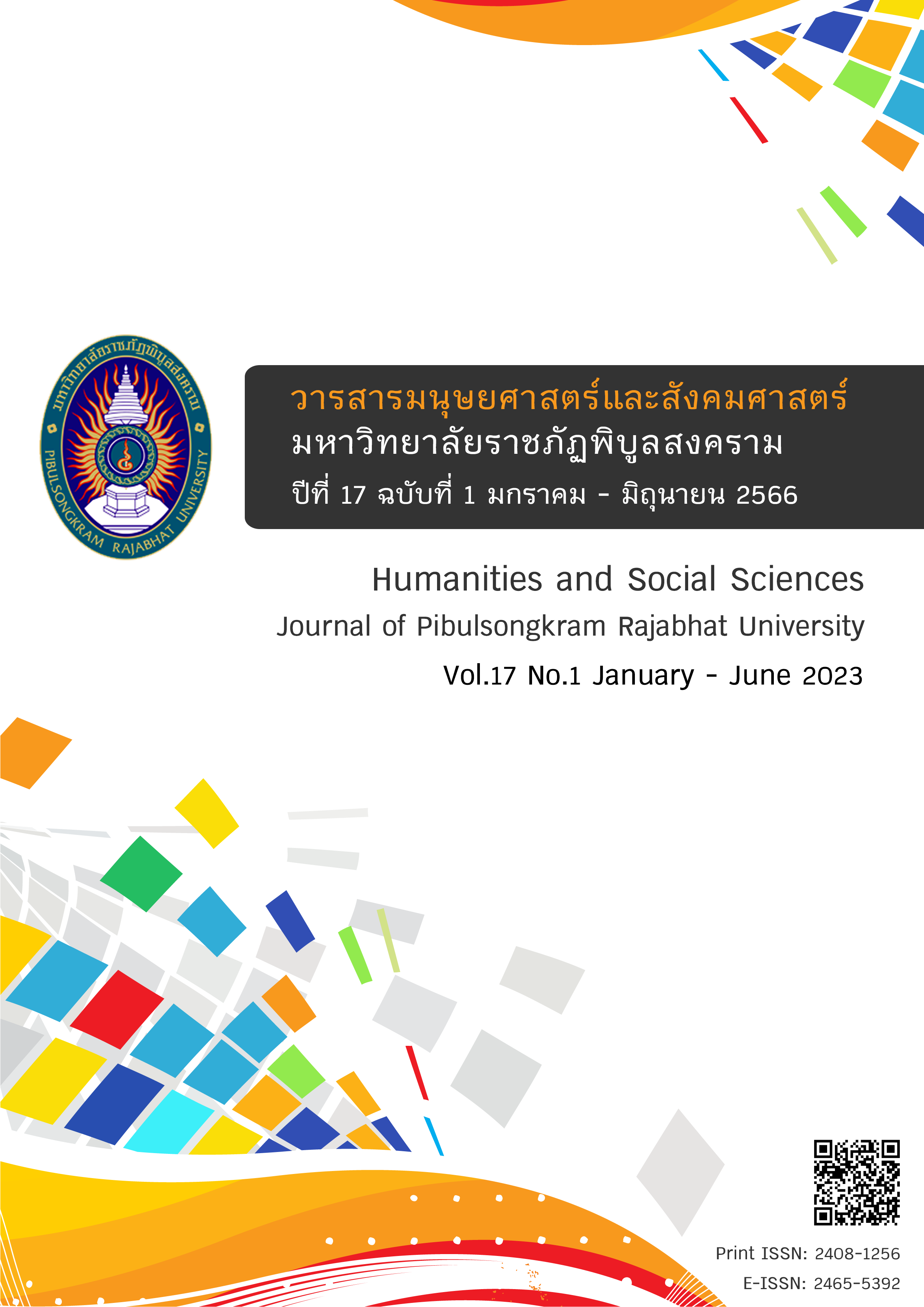Antecedents of Communal Engagement, Group Self-esteem, and Trust in member on Loyalty in Social Network Site
DOI:
https://doi.org/10.14456/psruhss.2023.4Keywords:
Customer loyalty, Communal engagement, Group self-esteem, Trust in membersAbstract
The objectives of this research is to examine factors influence Customer Loyalty as follows: Group Self-Esteem, Communal Engagement and Trust in Members who buy products from social network site. The researchers used quantitative method to 519 customers who buy products from social network site and analyzed by Structural Equation Model analysis from AMOS. The research findings: Communal Engagement, Trust in Member, and Group Self-Esteem have significantly positive influence on Customer Loyalty (p < .05).
References
Audrain-Pontevia, A. F., N’Goala, G., & Poncin, I. (2013). A good deal online: The Impacts of acquisition and transaction value on E-satisfaction and E-loyalty. Journal of Retailing and Consumer Services, 20(5), 445-452.
Brodie, R. J., Ilic, A., Juric, B., & Hollebeek, L. (2013). Consumer engagement in a virtual brand community: An exploratory analysis. Journal of business research, 66(1), 105-114.
Cai, S., & Xu, Y. (2006). Effects of outcome, process and shopping enjoyment on online consumer behaviour. Electronic Commerce research and applications, 5(4), 272-281.
Cheng, Z. C., & Guo, T. C. (2015). The formation of social identity and self-identity based on knowledge contribution in virtual communities: An inductive route model. Computers in Human Behavior, 43, 229-241.
Cheung, C. M., & Lee, M. K. (2010). A theoretical model of intentional social action in online social networks. Decision support systems, 49(1), 24-30.
Chiu, C-H., Cheng, H-L., Huang, H-Y, & Chen, C-F. (2013). Exploring individuals’ subjective well-being and loyalty towards social network sites from the perspective of network externalities: The Facebook use. International journal of information management, 33, 539-552.
Comrey, A. L., & Lee, H. B. (1992). A first course in factor analysis. Hillsdals, NJ: Erlbaum.
Cyr, D., Head, M., & Ivanov, A. (2009). Perceived interactivity leading to e-loyalty: Development of a model for cognitive–affective user responses. International Journal of Human-computer studies, 67(10), 850-869.
Durmuş, B., Ulusu, Y., & Erdem, Ş. (2013). Which dimensions affect private shopping e-customer loyalty?. Procedia-Social and Behavioral Sciences, 99, 420-427.
Ellemers, N., Kortekaas, P., & Ouwerkerk, J. W. (1999). Self‐categorisation, commitment to the group and group self‐esteem as related but distinct aspects of social identity. European journal of social psychology, 29(2‐3), 371-389.
Field, A. P. 2005). Discovering statistics using SPSS (2 ed.). Thousand Okes, CA: Sage Publications.
Gamboa, A. M., & Gonçalves, H. M. (2014). Customer loyalty through social networks: Lessons from Zara on Facebook. Business horizons, 57(6), 709-717.
Gefen, D., Straub, D., & Boudreau, M. C. (2000). Structural equation modeling and regression: Guidelines for research practice. Communications of the association for information systems, 4(1), 7.
Hair, J. F., Black, W. C., Babin, B. J. & Anderson, R. E. (2010). Multivariate Data Analysis (7th ed.). Upper Saddle River, NJ: Prentice Hall.
Hsu, C. P., Chiang, Y. F., & Huang, H. C. (2012). How experience‐driven community identification generates trust and engagement. Online Information Review, 36(1), 72-88.
Laroche, M., Habibi, M. R., Richard, M. O., & Sankaranarayanan, R. (2012). The effects of social media based brand communities on brand community markers, value creation practices, brand trust and brand loyalty. Computers in human behavior, 28(5), 1755-1767.
Li, D. C. (2011). Online social network acceptance: a social perspective. Internet Research, 21(5), 562-580.
Lim, J. S., Hwang, Y., Kim, S., & Biocca, F. A. (2015). How social media engagement leads to sports channel loyalty: Mediating roles of social presence and channel commitment. Computers in Human Behavior, 46, 158-167.
Lin, H. H., & Wang, Y. S. (2006). An examination of the determinants of customer loyalty in mobile commerce contexts. Information & management, 43(3), 271-282.
Lu, Y., Zhao, L., & Wang, B. (2010). From virtual community members to C2C e-commerce buyers: Trust in virtual communities and its effect on consumers’ purchase intention. Electronic commerce research and applications, 9(4), 346-360.
Narakorn, P., & Seesupan, T. (2018). The influence of social network site identity, active control, flow, trust in members and customer loyalty of Facebooks users. Silpakorn University Journal, 38(2), 121-145.
Narakorn, P., & Seesupan, T. (2018). Trust in seller catalyst social commerce constructs to continuance intention. Journal of Business Administration, 41(159), 24-44.
Nunnally, J. C. (1978). Psychometric Theory (2nd ed.). McGraw-Hill, NY: New York.
Seesupan, T., & Narakorn, P. (2018). The influence of social commerce, social support, satisfaction, commitment and trust to intention to co-creation in brand and continuance intention. Humanities, Arts and Social Sciences Studies, 18(1), 209-235.
Srinivasan, S. S., Anderson, R., & Ponnavolu, K. (2002). Customer loyalty in e-commerce: an exploration of its antecedents and consequences. Journal of retailing, 78(1), 41-50.
Svensson, G. (2001). Extending trust and mutual trust in business relationships towards a synchronised trust chain in marketing channels. Management Decision, 39(6), 431-440.
Tsiotsou, R. H. (2015). The role of social and parasocial relationships on social networking sites loyalty. Computers in human behavior, 48, 401-414.
Wang, H., Meng, Y., & Wang, W. (2013). The role of perceived interactivity in virtual communities: building trust and increasing stickiness. Connection Science, 25(1), 55-73.
Downloads
Published
How to Cite
Issue
Section
License
Copyright (c) 2022 Humanities and Social Sciences Journal of Pibulsongkram Rajabhat University

This work is licensed under a Creative Commons Attribution-NonCommercial-NoDerivatives 4.0 International License.
Any articles or comments appearing in the Journal of Humanities and Social Sciences, Rajabhat Phibulsongkram University, are the intellectual property of the authors, and do not necessarily reflect the views of the editorial board. Published articles are copyrighted by the Journal of Humanities and Social Sciences, Rajabhat Phibulsongkram University.









